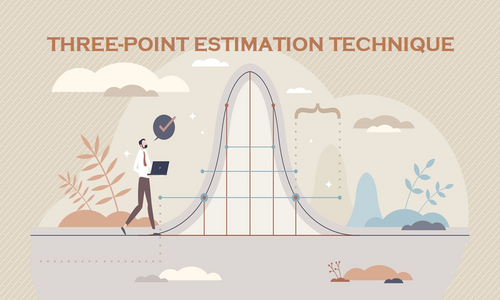In the realm of project management, accurate estimation is a cornerstone for success. Estimating the time, effort, and resources required for a project is essential to ensure its successful completion within budget and on schedule. One technique that has gained prominence for its ability to provide more realistic estimates is the Three-Point Estimation Technique. This approach goes beyond traditional single-point estimates by considering optimistic, pessimistic, and most likely scenarios. Let us look into the intricacies of the Three-Point Estimation Technique and understand how it can enhance project estimation accuracy.

Jump ahead to
Basics of Three-Point Estimation
Three-Point Estimation, also known as the PERT (Program Evaluation and Review Technique) method, was developed during the U.S. Navy’s Polaris missile project in the 1950s. It takes a more comprehensive view of the variables that can affect project tasks and durations. Instead of relying solely on a single estimate, the technique uses three estimates for each task:
- Optimistic Estimate (O): This is the best-case scenario estimate. It represents the shortest possible time required to complete a task, assuming everything goes exceptionally well.
- Pessimistic Estimate (P): This is the worst-case scenario estimate. It accounts for all potential obstacles, delays, and complications that could arise during task execution.
- Most Likely Estimate (M): This is the estimate that reflects the most realistic scenario considering normal circumstances and typical challenges.
Three-Point Estimation Formula
To calculate a more accurate estimate using the Three-Point Estimation Technique, the following formula is commonly used:
Estimated Duration (TE) = (O + 4M + P) / 6
The formula puts more weight on the most likely estimate while incorporating the range defined by the optimistic and pessimistic estimates. This weighted average helps to reduce the impact of extreme values and provides a balanced prediction.
Benefits of Three-Point Estimation
- Enhanced Accuracy: The technique’s incorporation of multiple scenarios results in estimates that are closer to reality. By considering both best-case and worst-case scenarios, it provides a more balanced and accurate prediction of task durations.
- Risk Management: Three-Point Estimation inherently factors in risks and uncertainties. Project Management Professionals can identify potential roadblocks and allocate resources to mitigate these challenges, reducing the overall project risk.
- Improved Decision Making: With a more comprehensive estimate, stakeholders can make informed decisions about project timelines, resource allocation, and budgeting. This promotes better planning and resource management.
- Clearer Communication: The technique encourages transparent communication among team members and stakeholders. It fosters discussions about assumptions, risks, and potential issues, leading to a shared understanding of project complexities.
- Realistic Expectations: Three-Point Estimation sets a more realistic tone for project expectations. It prevents over-optimistic scheduling, which can lead to disappointment and frustration if not met.
Steps to Implement Three-Point Estimation
1. Identify Tasks: Break down the project into individual tasks or activities. Each task should be well-defined and have a clear deliverable.
2. Gather Estimates: Consult domain experts, team members, and historical data to collect the optimistic, pessimistic, and most likely estimates for each task.
3. Apply the Formula: Plug the gathered estimates into the Three-Point Estimation formula to calculate the estimated duration for each task.
4. Analyze Results: Review the calculated estimates for each task. Identify tasks with high variability between the three estimates, as these may require closer attention and risk management strategies.
5. Allocate Resources: Use the estimated durations to allocate resources, set priorities, and plan project schedules. Be sure to consider dependencies between tasks.
6. Continuous Monitoring: Throughout the project, monitor the actual time taken for each task and compare it with the estimated duration. This will provide valuable feedback for refining future estimations.
7. Adapt and Learn: Project Management Professionals should continuously learn from discrepancies between estimates and actual outcomes. Over time, this iterative process improves the accuracy of future estimations.
Limitations and Considerations
While the Three-Point Estimation Technique offers significant advantages, it’s important to acknowledge its limitations:
- Complexity: Applying this technique can be time-consuming, especially for projects with a large number of tasks. It requires thorough data collection and analysis.
- Subjectivity: The estimates are influenced by human judgment and expertise, which can introduce bias. Ensuring a diverse range of inputs can help mitigate this.
- Changing Variables: External factors such as market trends, technology advancements, or unforeseen events can significantly impact project timelines, rendering initial estimates less accurate.
- Skill Level: The accuracy of estimates heavily relies on the skill and experience of those providing the input. Novices might struggle to provide reliable estimates.
Conclusion
Accurate project estimation is a critical factor in project success. The Three-Point Estimation Technique brings a holistic approach to estimating by considering optimistic, pessimistic, and most likely scenarios. This technique’s ability to incorporate uncertainties and risks results in more realistic predictions, enabling better decision-making, resource allocation, and risk management. While it requires effort and expertise to implement, the benefits it offers in terms of enhanced accuracy and improved project outcomes make it a valuable tool in the PMP Certified project manager’s toolkit. By continuously learning from discrepancies and refining estimates over time, Certified Project Management Professionals can harness the power of the Three-Point Estimation Technique. This helps in navigating the complex landscape of project management with greater confidence.



